Exploring Spatio-Temporal Variations of Ecological Risk in the Yellow River Ecological Economic Belt Based on an Improved Landscape Index Method
Abstract
1. Introduction
2. Materials and Methods
2.1. Study Area
2.2. Data Sources
2.3. Methods
2.3.1. Landscape Ecological Risk Index Model Construction
2.3.2. Analysis of the Spatial and Temporal Variation of LERI
3. Results
3.1. Evolution of Land Use Landscape Pattern
3.2. Spatiotemporal Dynamics of Landscape Ecological Risk
3.2.1. Spatial Patterns of Landscape Ecological Risk
- The improved landscape ecological risk model was used to calculate the LERI of 5048 evaluation units in five periods and to find the LERI of the YREEB and each province respectively (Figure 4). The average LERI values of the YREEB in 2000, 2005, 2010, 2015, and 2020 were 1.3443, 1.3275, 1.3142, 1.3107, and 1.2180, respectively. This leads to no particularly significant change in the value at risk for the region, but there was a significant downward trend. The provincial-scale value showed a similar trend. The overall ecological situation in most provinces improved significantly from 2000 to 2015, as evidenced by decreasing risk, and then stabilized after 2015. The provinces of Shanxi, Ningxia, and Qinghai had relatively higher risks (Figure 4). The overall landscape structure of these regions were relatively fragmented, and the stability and resilience of ecosystems were poor. The risk to Shandong and Henan were relatively low, which indicated that the landscape resilience of these regions was better than that of the western regions. The ecological risks of Shandong and Henan showed an increasing trend from 2000 to 2010, indicating that the ecological protection and development were ignored while developing the economy in this period, which increased the vulnerability of the environment and the ecological risks. The overall risk of most provinces in this period was reduced, indicating that the ecological situation was significantly improved, thus reducing the ecological risks. Since 2010, each province has basically shown a stable development trend.
- The ecological risk index is divided into five grades by using the Natural Breaks method: low ecological risk (LERI < 0.60), medium-low ecological risk (0.60 ≤ LERI < 1.18), medium ecological risk (1.18 ≤ LERI < 1.72), medium-high ecological risk (1.72 ≤ LERI < 2.40), and high ecological risk (LERI > 2.4). The proportion of the risk index of each region is obtained and shown in Figure 5. The proportion of high ecological risk areas for the entire region has decreased from 2000 to 2020, from 9.5% to 7.4% (Figure 5a), and the number of units has decreased by 103. The proportion of low ecological risks remained almost unchanged, while the proportion of medium and low risks continued to increase. The trend of risk structure for each province was similar to that for the whole YREEB. The proportion of high risk categories in Qinghai, Gansu, and Shaanxi generally declined, while the proportion of low- and medium-risk areas increased (Figure 5b–h). The proportion of high-risk categories in Ningxia increased first and then decreased. The proportion of medium- and high-risk categories was relatively high (Figure 5d). The proportion of high-risk categories in Shanxi decreased first and then increased, reaching the highest amount in 2010, but only 1.1%. However, the proportion of medium- and high-risk categories in Shanxi was the largest in all regions, reaching 65.5% in 2000. The proportion of low- and medium-low-risk categories was the lowest in all regions (Figure 5f). The proportion of medium- and low-risk categories in Henan was the highest in all regions, with a value higher than 58% (Figure 5g). It can be concluded from the average number of units with different risk levels in each province that the regions with a high proportion of high risks were mainly concentrated in Gansu and Qinghai, and low-risk and medium-low-risk units are mainly concentrated in Henan and Shandong (Figure 5i). Henan Province had no high-risk areas, and Ningxia was dominated by medium- and high-risk units. However, due to the small size of the province, the impact on changes in the overall YREEB risk structure was weak.
- At the grid scale, the low-risk areas are generally widely distributed, mainly in Yellow River estuary areas of Shandong and Henan province (Figure 6). Human activities in the above areas were relatively infrequent, and the loss degree after human interference and the landscape interference index was small. In addition, the land use type in this area was mainly cultivated land with high land cover continuity, so the vulnerability and fragmentation of this landscape was low. The risks in the north and south sides of Qinghai were also low, because the main dominant landscapes in this area were large areas of grassland and unused land, with less human interference, good vegetation growth conditions, and good ecological protection. The medium-risk areas were mainly distributed in the middle of the study area in blocks, and only scattered in the southwest and northeast, which are mostly located in the transition area between the lower-risk areas and the higher-risk areas. The medium- and high-risk areas are relatively concentrated, mainly located in the western region, including the areas around Qinghai Lake, Qilian Mountain, and southern Gansu, where the surface vegetation was sparse, the biodiversity is low, and the land use type is single. The spatial change of ecological risk had a typical zone transition, which showed that the relatively medium-risk area appeared in the periphery of the relatively low-risk area and the relatively high-risk area, forming a gradient change of ecological risk. From 2000 to 2020, low-risk and medium-low-risk areas expanded, especially in Shanxi and Shaanxi.
3.2.2. Spatiotemporal Differences in Risk Changes
3.3. Key Areas for Ecological Risk Management
4. Discussion
4.1. Spatiotemporal Differentiation of Factors Influencing LERI
4.2. Implications for Management
4.3. Limitations and Future Research
5. Conclusions
Author Contributions
Funding
Institutional Review Board Statement
Informed Consent Statement
Data Availability Statement
Acknowledgments
Conflicts of Interest
References
- Hao, H. Analysis of Ecological Environment Problems and Countermeasures in Ideological and Political Education in Colleges and Universities. J. Environ. Public Health 2022, 2022, 9479881. [Google Scholar] [CrossRef] [PubMed]
- Wang, B.; Ding, M.; Li, S.; Liu, L.; Ai, J. Assessment of landscape ecological risk for a cross-border basin: A case study of the Koshi River Basin, central Himalayas. Ecol. Indic. 2020, 117, 106621. [Google Scholar] [CrossRef]
- Forbes, V.E.; Galic, N. Next-generation ecological risk assessment: Predicting risk from molecular initiation to ecosystem service delivery. Environ. Int. 2016, 91, 215–219. [Google Scholar] [CrossRef] [PubMed]
- Karr, J.R.; Chu, E.W. Biological monitoring: Essential foundation for ecological risk assessment. Hum. Ecol. Risk Assess. Int. J. 1997, 3, 993–1004. [Google Scholar] [CrossRef]
- Hull, R.N.; Suter, G.; Barnthouse, L. Comparability of human and ecological risk assessments: Ecological risk assessments have been less influential than human health risk assessments. Hum. Ecol. Risk Assess. Int. J. 1995, 1, 482–484. [Google Scholar] [CrossRef]
- Peng, J.; Dang, W.; Liu, Y.; Zong, M.; Hu, X. Review on landscape ecological risk assessment. Acta Geol. Sin. 2015, 70, 664–677. [Google Scholar]
- Chen, X.; Xie, G.; Zhang, J. Landscape ecological risk assessment of land use changes in the coastal area of Haikou City in the past 30 years. Acta Ecol. Sin. 2021, 41, 975–986. [Google Scholar]
- Malekmohammadi, B.; Blouchi, L.R. Ecological risk assessment of wetland ecosystems using multi criteria decision making and geographic information system. Ecol. Indic. 2014, 41, 133–144. [Google Scholar] [CrossRef]
- Ran, P.; Hu, S.; Frazier, A.E.; Qu, S.; Yu, D.; Tong, L. Exploring changes in landscape ecological risk in the Yangtze River Economic Belt from a spatiotemporal perspective. Ecol. Indic. 2022, 137, 108744. [Google Scholar] [CrossRef]
- Hunsaker, C.T.; Graham, R.L.; Suter, G.W.; O’Neill, R.V.; Barnthouse, L.W.; Gardner, R.H. Assessing ecological risk on a regional scale. Environ. Manag. 1990, 14, 325–332. [Google Scholar] [CrossRef]
- Van der Oost, R.; Beyer, J.; Vermeulen, N.P. Fish bioaccumulation and biomarkers in environmental risk assessment: A review. Environ. Toxicol. Pharmacol. 2003, 13, 57–149. [Google Scholar] [CrossRef] [PubMed]
- Huang, L.; He, C.; Wang, B. Study on the spatial changes concerning ecosystem services value in Lhasa River Basin, China. Environ. Sci. Pollut. Res. 2022, 29, 7827–7843. [Google Scholar] [CrossRef]
- Tian, Y.; Wu, H.; Zhang, G.; Wang, L.; Zheng, D.; Li, S. Perceptions of ecosystem services, disservices and willingness-to-pay for urban green space conservation. J. Environ. Manag. 2020, 260, 110140. [Google Scholar] [CrossRef] [PubMed]
- Wu, J. Landscape sustainability science: Ecosystem services and human well-being in changing landscapes. Landsc. Ecol. 2013, 28, 999–1023. [Google Scholar] [CrossRef]
- Du, Y.; Peng, J.; Zhao, S.; Hu, Z.; Wang, Y. Ecological risk assessment of landslide disasters in mountainous areas of Southwest China: A case study in Dali Bai Autonomous Prefecture. Acta Geol. Sin. 2016, 71, 1544–1561. [Google Scholar]
- Yang, Q.; Li, Z.; Lu, X.; Duan, Q.; Huang, L.; Bi, J. A review of soil heavy metal pollution from industrial and agricultural regions in China: Pollution and risk assessment. Sci. Total Environ. 2018, 642, 690–700. [Google Scholar] [CrossRef]
- Wang, H.; Rao, E.; Xiao, Y.; Yan, Y.; Lu, H.; Zhu, J. Ecological risk assessment in Southwest China based on multiple risk sources. Acta Ecol. Sin. 2018, 38, 8992–9000. [Google Scholar]
- Tang, L.; Wang, H.; Wang, L.; Qiu, Q. Landscape pattern optimization for Xianghe segment of China’s grand canal. Int. J. Sustain. Dev. World Ecol. 2016, 23, 305–311. [Google Scholar] [CrossRef]
- Hua, L.; Liao, J.; Chen, H.; Chen, D.; Shao, G. Assessment of ecological risks induced by land use and land cover changes in Xiamen City, China. Int. J. Sustain. Dev. World Ecol. 2018, 25, 439–447. [Google Scholar] [CrossRef]
- Du, J.; Zhao, S.; Qiu, S.; Guo, L. Land Use Change and Landscape Ecological Risk Assessment in Loess Hilly Region of Western Henan Province from 2000 to 2015. Acta Ecol. Sin. 2021, 28, 279–284. [Google Scholar]
- Hou, R.; Li, H.; Gao, Y. Ecological Risk Assessment of Land Use in Jiangxia District of Wuhan Based on Landscape Pattern. Acta Ecol. Sin. 2021, 28, 323–330. [Google Scholar]
- Zhu, M.; Li, B.; Liu, G. Groundwater risk assessment of abandoned mines based on pressure-state-response—The example of an abandoned mine in southwest China. Energy Rep. 2022, 8, 10728–10740. [Google Scholar] [CrossRef]
- Hardi, P.; Pinter, L. Models and Methods of Measuring Sustainable Development Performance; International Institute for Sustainable Development: Winniped, MB, Canada, 1995. [Google Scholar]
- Liu, H.; Wang, N.; Xie, J.; Zhu, J. Assessment of ecological vulnerability based on fuzzy comprehensive evaluation in Weihe River Basin. J. Shenyang Agric. Univ. 2014, 45, 73–77. [Google Scholar]
- Xian, W.; Li, T.; Shao, H. Ecological frangibility evaluation of Anning River Basin in the Upper Yangtze River based on support vector machine. Environ. Sci. Technol. 2014, 37, 180–184. [Google Scholar]
- Ma, L.; He, C.; Bian, H.; Sheng, L. MIKE SHE modeling of ecohydrological processes: Merits, applications, and challenges. Ecol. Eng. 2016, 96, 137–149. [Google Scholar] [CrossRef]
- Jonsson, M.; Bommarco, R.; Ekbom, B.; Smith, H.G.; Bengtsson, J.; Caballero-Lopez, B.; Winqvist, C.; Olsson, O. Ecological production functions for biological control services in agricultural landscapes. Methods Ecol. Evol. 2014, 5, 243–252. [Google Scholar] [CrossRef]
- Xing, L.; Hu, M.; Wang, Y. Integrating ecosystem services value and uncertainty into regional ecological risk assessment: A case study of Hubei Province, Central China. Sci. Total Environ. 2020, 740, 140126. [Google Scholar] [CrossRef]
- Xie, H.; Wen, J.; Chen, Q.; Wu, Q. Evaluating the landscape ecological risk based on GIS: A case-study in the poyang lake region of China. Land Degrad. Dev. 2021, 32, 2762–2774. [Google Scholar] [CrossRef]
- Gong, J.; Cao, E.; Xie, Y.; Xu, C.; Li, H.; Yan, L. Integrating ecosystem services and landscape ecological risk into adaptive management: Insights from a western mountain-basin area, China. J. Environ. Manag. 2021, 281, 111817. [Google Scholar] [CrossRef]
- Mo, W.; Wang, Y.; Zhang, Y.; Zhuang, D. Impacts of road network expansion on landscape ecological risk in a megacity, China: A case study of Beijing. Sci. Total Environ. 2017, 574, 1000–1011. [Google Scholar] [CrossRef]
- Gallina, V.; Torresan, S.; Critto, A.; Sperotto, A.; Glade, T.; Marcomini, A. A review of multi-risk methodologies for natural hazards: Consequences and challenges for a climate change impact assessment. J. Environ. Manag. 2016, 168, 123–132. [Google Scholar] [CrossRef] [PubMed]
- Whitlock, C.; Higuera, P.E.; McWethy, D.B.; Briles, C.E. Paleoecological perspectives on fire ecology: Revisiting the fire-regime concept. Open Ecol. J. 2010, 3, 6–23. [Google Scholar] [CrossRef]
- Douvere, F. The importance of marine spatial planning in advancing ecosystem-based sea use management. Mar. Policy 2008, 32, 762–771. [Google Scholar] [CrossRef]
- Troy, A.; Wilson, M.A. Mapping ecosystem services: Practical challenges and opportunities in linking GIS and value transfer. Ecol. Econ. 2006, 60, 435–449. [Google Scholar] [CrossRef]
- Zhang, J.; Feng, Y.; Zhu, Z. Spatio-Temporal Heterogeneity of Carbon Emissions and Its Key Influencing Factors in the Yellow River Economic Belt of China from 2006 to 2019. Int. J. Environ. Res. Public Health 2022, 19, 4185. [Google Scholar] [CrossRef]
- Jiang, W.; Gao, W.; Gao, X.; Ma, M.; Zhou, M.; Du, K.; Ma, X. Spatio-temporal heterogeneity of air pollution and its key influencing factors in the Yellow River Economic Belt of China from 2014 to 2019. J. Environ. Manag. 2021, 296, 113172. [Google Scholar] [CrossRef] [PubMed]
- Wang, Y.; Wang, H.; Liu, G.; Zhang, J.; Fang, Z. Factors driving water yield ecosystem services in the Yellow River Economic Belt, China: Spatial heterogeneity and spatial spillover perspectives. J. Environ. Manag. 2022, 317, 115477. [Google Scholar] [CrossRef] [PubMed]
- Ge, G.; Zhang, J.; Chen, X.; Liu, X.; Hao, Y.; Yang, X.; Kwon, S. Effects of land use and land cover change on ecosystem services in an arid desert-oasis ecotone along the Yellow River of China. Ecol. Eng. 2022, 176, 106512. [Google Scholar] [CrossRef]
- Geng, W.; Li, Y.; Zhang, P.; Yang, D.; Jing, W.; Rong, T. Analyzing spatio-temporal changes and trade-offs/synergies among ecosystem services in the Yellow River Basin, China. Ecol. Indic. 2022, 138, 108825. [Google Scholar] [CrossRef]
- Liu, W.; Zhan, J.; Zhao, F.; Wang, C.; Zhang, F.; Teng, Y.; Chu, X.; Kumi, M.A. Spatio-temporal variations of ecosystem services and their drivers in the Pearl River Delta, China. J. Clean. Prod. 2022, 337, 130466. [Google Scholar] [CrossRef]
- Liu, D.; Qu, R.; Zhao, C. Landscape ecological risk assessment in Yellow River Delta. J. Food Agric. Environ. 2012, 10, 970–972. [Google Scholar]
- Li, M.; Tian, Q.; Yu, Y.; Xu, Y.; Li, C. Virtual Water Trade in the Yellow River Economic Belt: A Multi-Regional Input-Output Model. Water 2021, 13, 748. [Google Scholar] [CrossRef]
- Luo, H.; Zhang, L.; Zhang, X. Shifts in land-greening hotspots in the Yellow River Eco-Economic Belt during the last four decades and their connections to human activities. Remote Sens. Appl. Soc. Environ. 2022, 27, 100783. [Google Scholar] [CrossRef]
- Wu, X.; Hui, X. Economic Dependence Relationship and the Coordinated & Sustainable Development among the Provinces in the Yellow River Economic Belt of China. Sustainability 2021, 13, 5448. [Google Scholar]
- Sharma, A.; Liu, X.; Yang, X. Land cover classification from multi-temporal, multi-spectral remotely sensed imagery using patch-based recurrent neural networks. Neural Netw. 2018, 105, 346–355. [Google Scholar] [CrossRef] [PubMed]
- Li, S.; Xiao, W.; Zhao, Y.; Lv, X. Incorporating ecological risk index in the multi-process MCRE model to optimize the ecological security pattern in a semi-arid area with intensive coal mining: A case study in northern China. J. Clean. Prod. 2020, 247, 119143. [Google Scholar] [CrossRef]
- Cao, Q.; Zhang, X.; Lei, D.; Guo, L.; Sun, X.; Wu, J. Multi-scenario simulation of landscape ecological risk probability to facilitate different decision-making preferences. J. Clean. Prod. 2019, 227, 325–335. [Google Scholar] [CrossRef]
- Zhang, W.; Chang, W.J.; Zhu, Z.C.; Hui, Z. Landscape ecological risk assessment of Chinese coastal cities based on land use change. Appl. Geogr. 2020, 117, 102174. [Google Scholar] [CrossRef]
- Xu, W.; Wang, J.; Zhang, M.; Li, S. Construction of landscape ecological network based on landscape ecological risk assessment in a large-scale opencast coal mine area. J. Clean. Prod. 2021, 286, 125523. [Google Scholar] [CrossRef]
- Peng, J.; Zong, M.; Hu, Y.N.; Liu, Y.; Wu, J. Assessing landscape ecological risk in a mining city: A case study in Liaoyuan City, China. Sustainability 2015, 7, 8312–8334. [Google Scholar] [CrossRef]
- Darabi, H.; Islami Farsani, S.; Irani Behbahani, H. Evaluation of ecological vulnerability in Chelgard mountainous landscape. Pollution 2019, 5, 597–610. [Google Scholar]
- Mann, D.; Anees, M.M.; Rankavat, S.; Joshi, P.K. Spatio-temporal variations in landscape ecological risk related to road network in the Central Himalaya. Hum. Ecol. Risk Assess. Int. J. 2021, 27, 289–306. [Google Scholar] [CrossRef]
- Dalloz, M.F.; Crouzeilles, R.; Almeida-Gomes, M.; Papi, B.; Prevedello, J.A. Incorporating landscape ecology metrics into environmental impact assessment in the Brazilian Atlantic Forest. Perspect. Ecol. Conserv. 2017, 15, 216–220. [Google Scholar] [CrossRef]
- De Lange, H.; Sala, S.; Vighi, M.; Faber, J. Ecological vulnerability in risk assessment—A review and perspectives. Sci. Total Environ. 2010, 408, 3871–3879. [Google Scholar] [CrossRef] [PubMed]
- Chen, J.; Dong, B.; Li, H.; Zhang, S.; Peng, L.; Fang, L.; Zhang, C.; Li, S. Study on landscape ecological risk assessment of Hooded Crane breeding and overwintering habitat. Environ. Res. 2020, 187, 109649. [Google Scholar] [CrossRef]
- Lu, S.; Tang, X.; Guan, X.; Qin, F.; Liu, X.; Zhang, D. The assessment of forest ecological security and its determining indicators: A case study of the Yangtze River Economic Belt in China. J. Environ. Manag. 2020, 258, 110048. [Google Scholar] [CrossRef]
- Zhang, H.; Xu, E. An evaluation of the ecological and environmental security on China’s terrestrial ecosystems. Sci. Rep. 2017, 7, 811. [Google Scholar] [CrossRef]
- Jiang, L.; Huang, X.; Wang, F.; Liu, Y.; An, P. Method for evaluating ecological vulnerability under climate change based on remote sensing: A case study. Ecol. Indic. 2018, 85, 479–486. [Google Scholar] [CrossRef]
- Zou, Z.-H.; Yi, Y.; Sun, J.-N. Entropy method for determination of weight of evaluating indicators in fuzzy synthetic evaluation for water quality assessment. J. Environ. Sci. 2006, 18, 1020–1023. [Google Scholar] [CrossRef]
- Wu, Z.; Lin, C.; Shao, H.; Feng, X.; Chen, X.; Wang, S. Ecological risk assessment and difference analysis of pit ponds under different ecological service functions-A case study of Jianghuai ecological Economic Zone. Ecol. Indic. 2021, 129, 107860. [Google Scholar] [CrossRef]
- Zhong, Y.; Lin, A.; He, L.; Zhou, Z.; Yuan, M. Spatiotemporal dynamics and driving forces of urban land-use expansion: A case study of the Yangtze River economic belt, China. Remote Sens. 2020, 12, 287. [Google Scholar] [CrossRef]
- Döring, T.F.; Reckling, M. Detecting global trends of cereal yield stability by adjusting the coefficient of variation. Eur. J. Agron. 2018, 99, 30–36. [Google Scholar] [CrossRef]
- Yu, D.; Shi, P.; Han, G.; Zhu, W.; Du, S.; Xun, B. Forest ecosystem restoration due to a national conservation plan in China. Ecol. Eng. 2011, 37, 1387–1397. [Google Scholar] [CrossRef]
- García-Ruiz, J.M.; Lasanta, T.; Nadal-Romero, E.; Lana-Renault, N.; Álvarez-Farizo, B. Rewilding and restoring cultural landscapes in Mediterranean mountains: Opportunities and challenges. Land Use Policy 2020, 99, 104850. [Google Scholar] [CrossRef]
- Li, Y.; Cao, Z.; Long, H.; Liu, Y.; Li, W. Dynamic analysis of ecological environment combined with land cover and NDVI changes and implications for sustainable urban–rural development: The case of Mu Us Sandy Land, China. J. Clean. Prod. 2017, 142, 697–715. [Google Scholar] [CrossRef]
- Sun, M.; Yuan, Y.; Zhang, J.; Wang, R.; Wang, Y. Greenhouse gas emissions estimation and ways to mitigate emissions in the Yellow River Delta High-efficient Eco-economic Zone, China. J. Clean. Prod. 2014, 81, 89–102. [Google Scholar] [CrossRef]
- Savard, J.-P.L.; Clergeau, P.; Mennechez, G. Biodiversity concepts and urban ecosystems. Landsc. Urban Plan. 2000, 48, 131–142. [Google Scholar] [CrossRef]
- Falchi, F.; Cinzano, P.; Elvidge, C.D.; Keith, D.M.; Haim, A. Limiting the impact of light pollution on human health, environment and stellar visibility. J. Environ. Manag. 2011, 92, 2714–2722. [Google Scholar] [CrossRef]
- Chen, Y.; Zhu, M.; Lu, J.; Zhou, Q.; Ma, W. Evaluation of ecological city and analysis of obstacle factors under the background of high-quality development: Taking cities in the Yellow River Basin as examples. Ecol. Indic. 2020, 118, 106771. [Google Scholar] [CrossRef]
- Liu, K.; Qiao, Y.; Shi, T.; Zhou, Q. Study on coupling coordination and spatiotemporal heterogeneity between economic development and ecological environment of cities along the Yellow River Basin. Environ. Sci. Pollut. Res. 2021, 28, 6898–6912. [Google Scholar] [CrossRef]
- Zhang, P.; Pang, B.; Li, Y.; He, J.; Hong, X.; Qin, C.; Zheng, H. Analyzing spatial disparities of economic development in Yellow River Basin, China. GeoJournal 2019, 84, 303–320. [Google Scholar] [CrossRef]
- Zhao, G.; Liu, J.; Kuang, W.; Ouyang, Z.; Xie, Z. Disturbance impacts of land use change on biodiversity conservation priority areas across China: 1990–2010. J. Geogr. Sci. 2015, 25, 515–529. [Google Scholar] [CrossRef]
- Nian, Y.; Li, X.; Zhou, J.; Hu, X. Impact of land use change on water resource allocation in the middle reaches of the Heihe River Basin in northwestern China. J. Arid. Land 2014, 6, 273–286. [Google Scholar] [CrossRef]
- Liu, C.; Xia, J. Water problems and hydrological research in the Yellow River and the Huai and Hai River basins of China. Hydrol. Process. 2004, 18, 2197–2210. [Google Scholar] [CrossRef]
- Jin, H.; He, R.; Cheng, G.; Wu, Q.; Wang, S.; Lü, L.; Chang, X. Changes in frozen ground in the Source Area of the Yellow River on the Qinghai–Tibet Plateau, China, and their eco-environmental impacts. Environ. Res. Lett. 2009, 4, 045206. [Google Scholar] [CrossRef]
- Zhai, T.; Wang, J.; Fang, Y.; Qin, Y.; Huang, L.; Chen, Y. Assessing ecological risks caused by human activities in rapid urbanization coastal areas: Towards an integrated approach to determining key areas of terrestrial-oceanic ecosystems preservation and restoration. Sci. Total Environ. 2020, 708, 135153. [Google Scholar] [CrossRef]
- Guo, M.; Wang, S. Remote Sensing Monitoring and Ecological Risk Assessment of Landscape Patterning in the Agro-Pastoral Ecotone of Northeast China. Complexity 2021, 2021, 8851543. [Google Scholar] [CrossRef]
- Mueller, L.; Suleimenov, M.; Karimov, A.; Qadir, M.; Saparov, A.; Balgabayev, N.; Helming, K.; Lischeid, G. Land and water resources of Central Asia, their utilisation and ecological status. In Novel Measurement and Assessment Tools for Monitoring and Management of Land and Water Resources in Agricultural Landscapes of Central Asia; Springer: Berlin/Heidelberg, Germany, 2014; pp. 3–59. [Google Scholar]
- Shi, L.; Cai, Z.; Ding, X.; Di, R.; Xiao, Q. What factors affect the level of green urbanization in the Yellow River Basin in the context of new-type urbanization? Sustainability 2020, 12, 2488. [Google Scholar] [CrossRef]
- Liu, N.H.; Daumit, G.L.; Dua, T.; Aquila, R.; Charlson, F.; Cuijpers, P.; Druss, B.; Dudek, K.; Freeman, M.; Fujii, C. Excess mortality in persons with severe mental disorders: A multilevel intervention framework and priorities for clinical practice, policy and research agendas. World Psychiatry 2017, 16, 30–40. [Google Scholar] [CrossRef]
- Zhang, K.-m.; Wen, Z.-g. Review and challenges of policies of environmental protection and sustainable development in China. J. Environ. Manag. 2008, 88, 1249–1261. [Google Scholar] [CrossRef]
- Liu, H.; Hao, H.; Sun, L.; Zhou, T. Spatial–Temporal Evolution Characteristics of Landscape Ecological Risk in the Agro-Pastoral Region in Western China: A Case Study of Ningxia Hui Autonomous Region. Land 2022, 11, 1829. [Google Scholar] [CrossRef]
- Adekunle, V. Non-linear regression models for timber volume estimation in natural forest ecosystem, southwest Nigeria. Res. J. For. 2007, 1, 40–54. [Google Scholar]
- Boz, Y.; Yerdelen-Damar, S.; Aydemir, N.; Aydemir, M. Investigating the relationships among students’ self-efficacy beliefs, their perceptions of classroom learning environment, gender, and chemistry achievement through structural equation modeling. Res. Sci. Technol. Educ. 2016, 34, 307–324. [Google Scholar] [CrossRef]
- Hristozov, D.R.; Gottardo, S.; Critto, A.; Marcomini, A. Risk assessment of engineered nanomaterials: A review of available data and approaches from a regulatory perspective. Nanotoxicology 2012, 6, 880–898. [Google Scholar] [CrossRef] [PubMed]
- Jiang, J.; Wang, P.; Lung, W.-s.; Guo, L.; Li, M. A GIS-based generic real-time risk assessment framework and decision tools for chemical spills in the river basin. J. Hazard. Mater. 2012, 227, 280–291. [Google Scholar] [CrossRef] [PubMed]
- Qu, Y.; Zong, H.; Su, D.; Ping, Z.; Guan, M. Land Use Change and Its Impact on Landscape Ecological Risk in Typical Areas of the Yellow River Basin in China. Int. J. Environ. Res. Public Health 2021, 18, 11301. [Google Scholar] [CrossRef] [PubMed]
- Coglianese, C.; Nash, J.; Olmstead, T. Performance-based regulation: Prospects and limitations in health, safety, and environmental protection. Public Adm. Rev. 2003, 55, 705. [Google Scholar] [CrossRef]
- Maggi, F.; la Cecilia, D.; Tang, F.H.; McBratney, A. The global environmental hazard of glyphosate use. Sci. Total Environ. 2020, 717, 137167. [Google Scholar] [CrossRef]

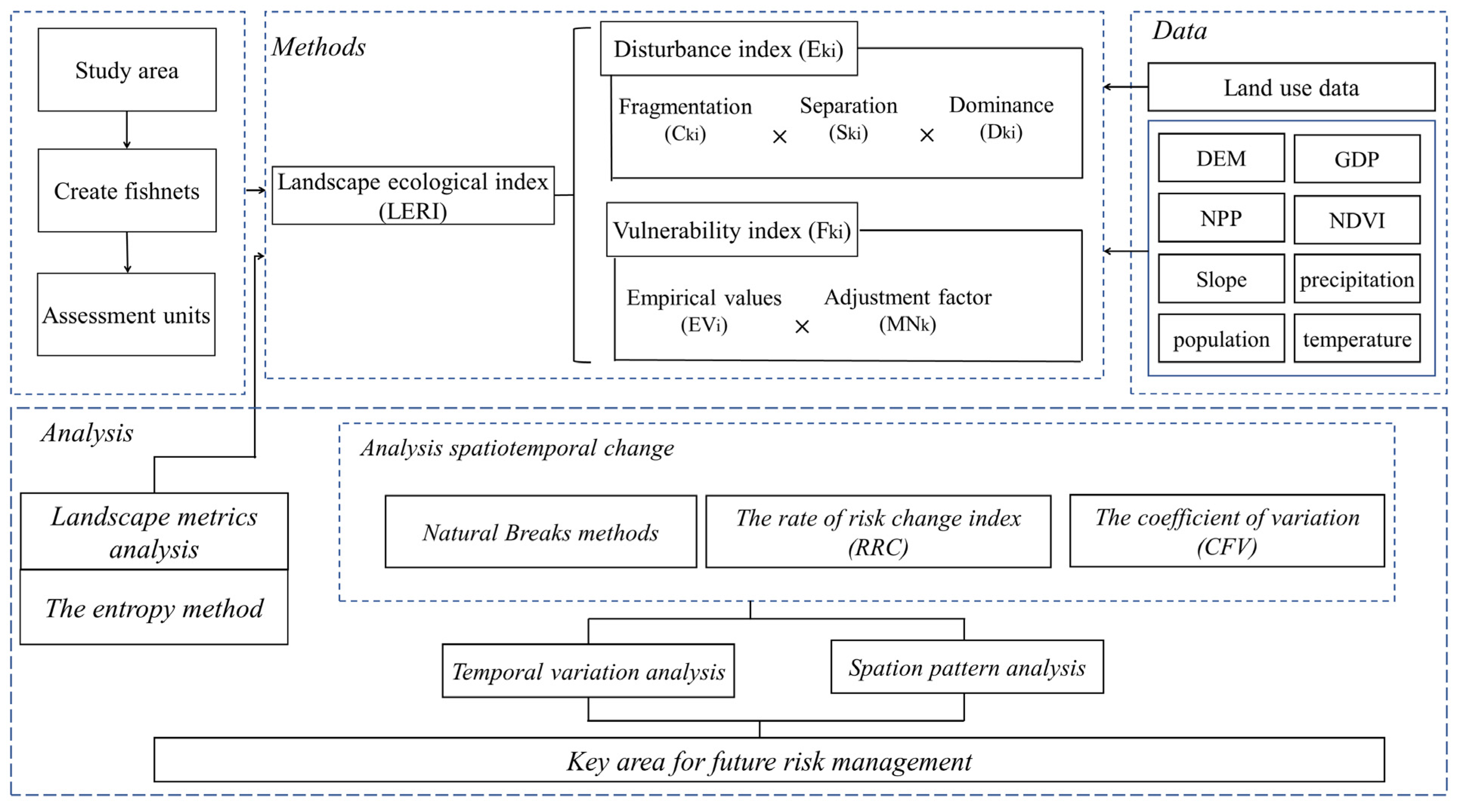
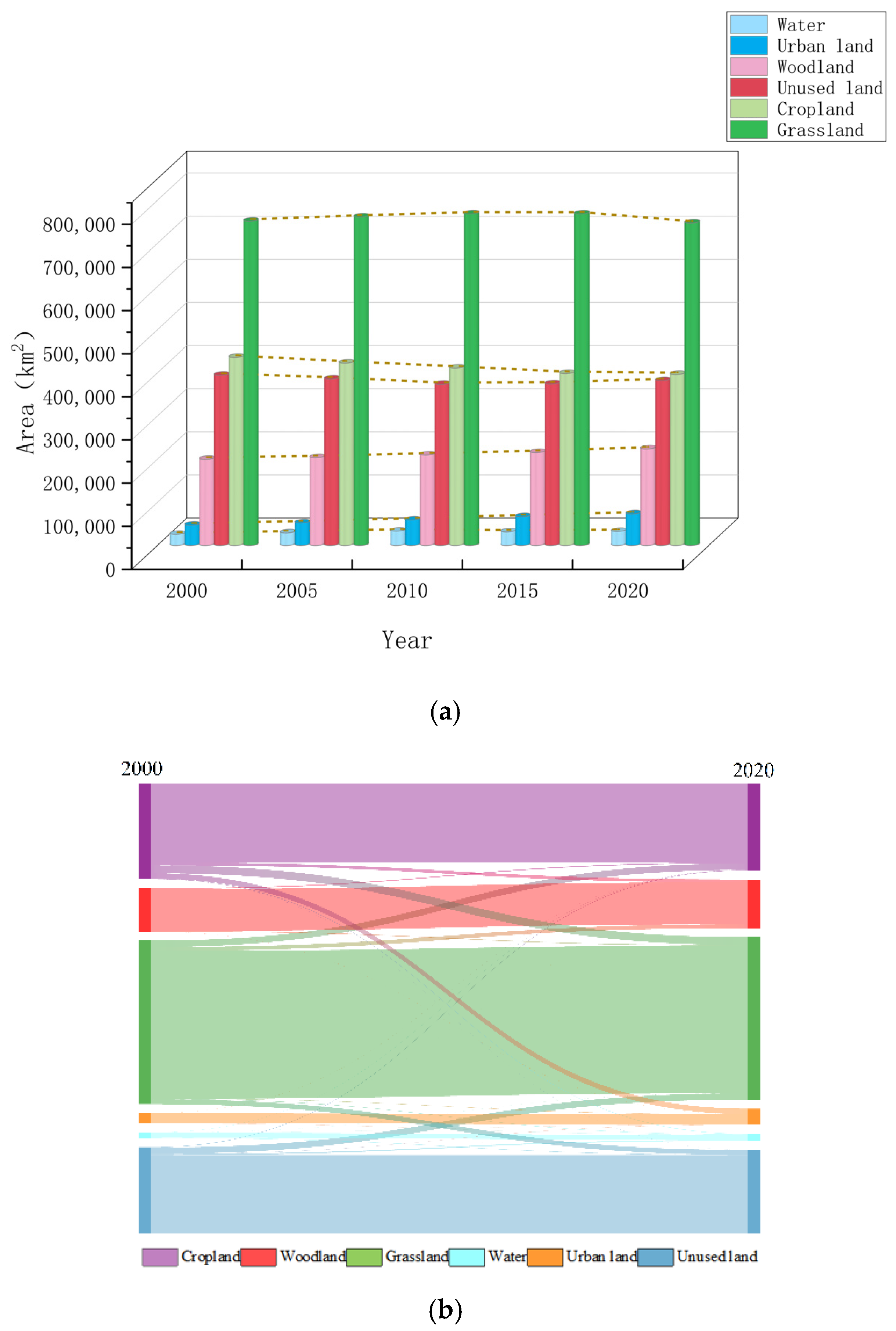
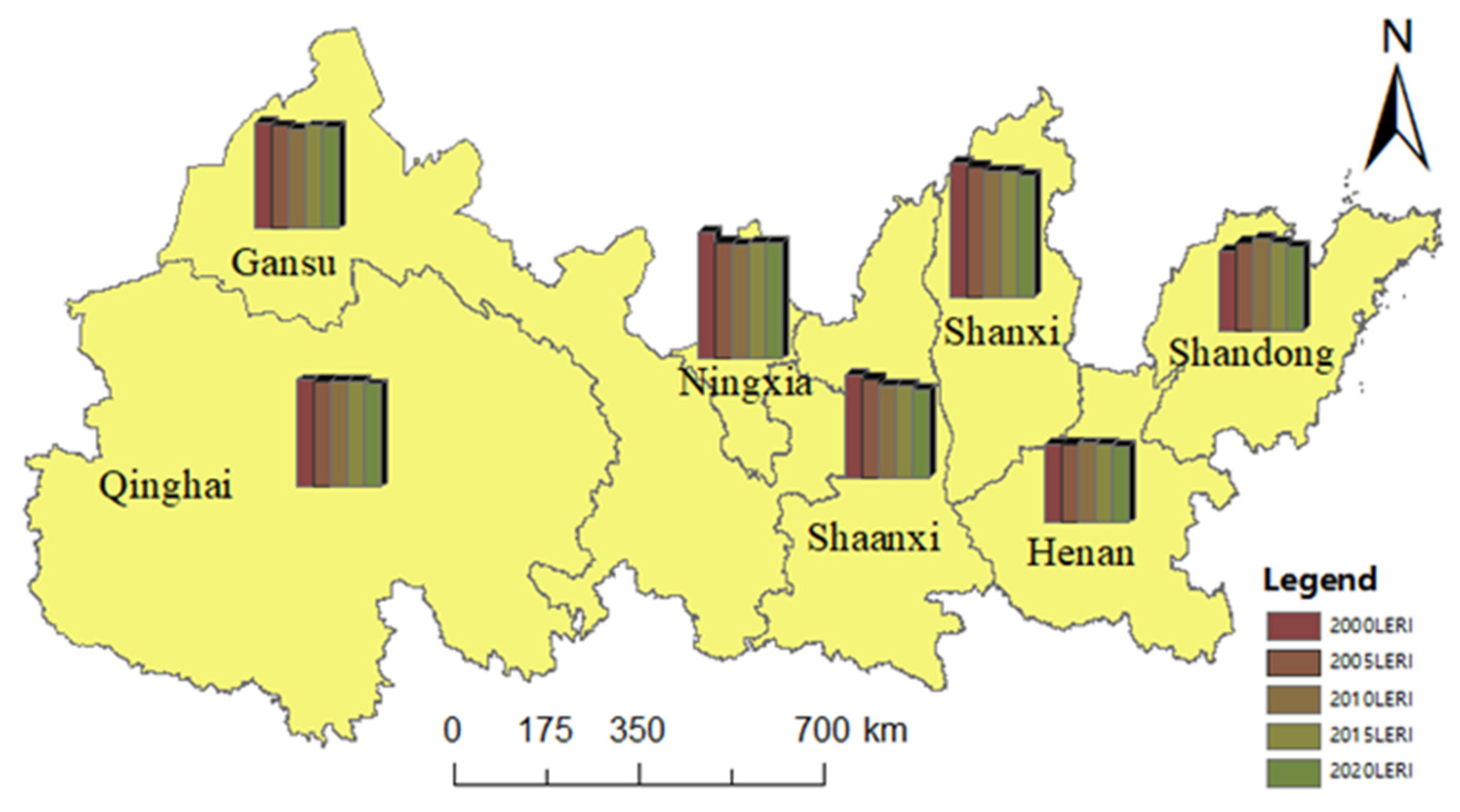
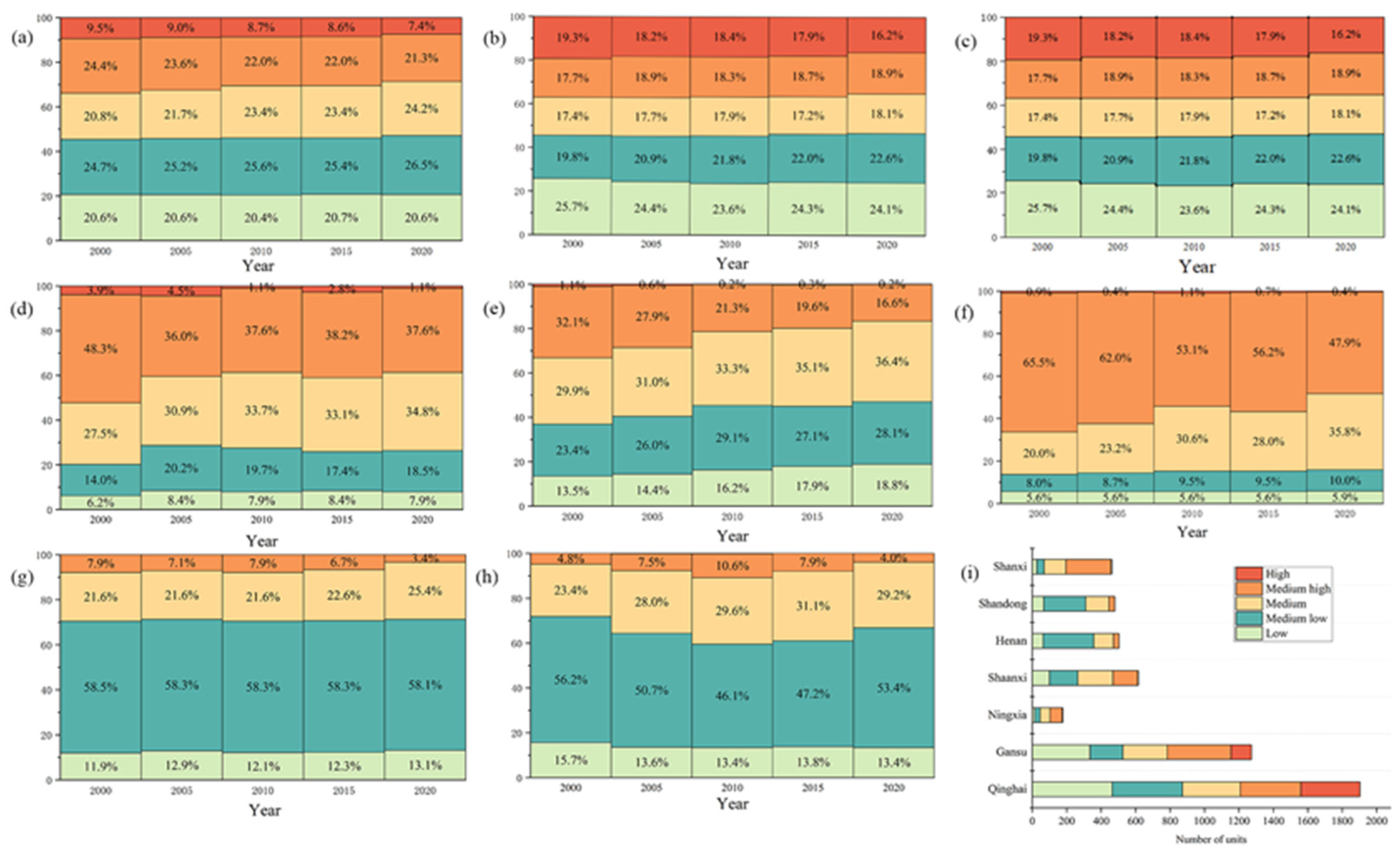
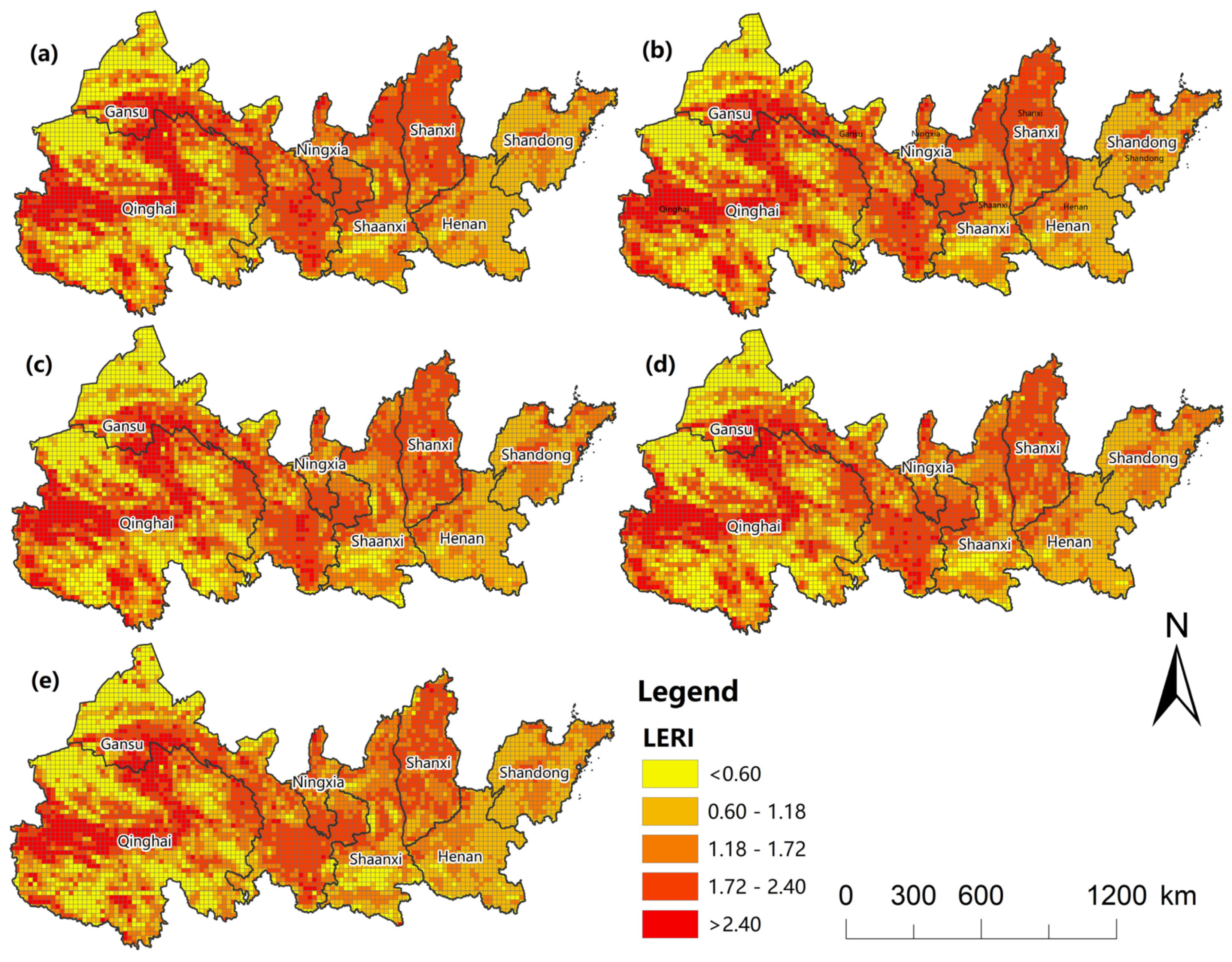
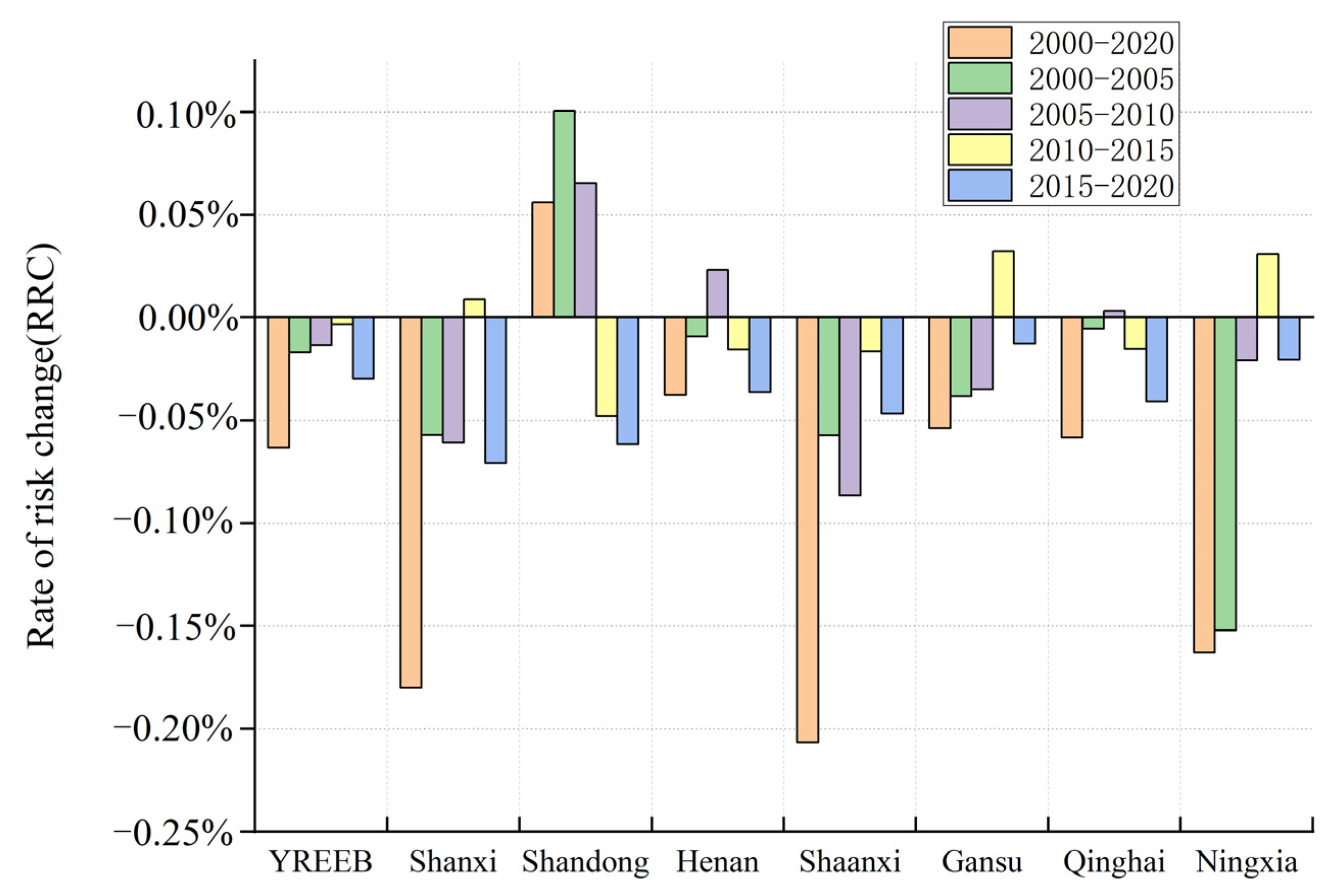


| Data | Resolution | Weight | Unit | Sources |
|---|---|---|---|---|
| Land use | 30 m | / | / | https://www.resdc.cn/Default.aspx (accessed on 1 June 2022) |
| GDP | 1000 m | 0.2421 | 104 yuan/km2 | http://www.geodata.cn (accessed on 2 June 2022) |
| Population | 1000 m | 0.1467 | Pop/km2 | https://www.resdc.cn/Default.aspx (accessed on 2 June 2022) |
| Elevation | 30 m | 0.1482 | m | http://www.resdc.cn (accessed on 4 June 2022) |
| Slope | 30 m | 0.0985 | % | http://www.resdc.cn (accessed on 4 June 2022) |
| Temperature | 1000 m | 0.0892 | °C | http://data.cma.cn (accessed on 5 June 2022) |
| Precipitation | 1000 m | 0.0647 | Mm | http://data.cma.cn (accessed on 6 June 2022) |
| NPP | 1000 m | 0.1023 | g·C/m2 | http://modis.gsfc.nasa.gov (accessed on 7 June 2022) |
| NDVI | 1000 m | 0.1083 | / | https://www.usgs.gov (accessed on 7 June 2022) |
| Landscape Index | Equation | Implications |
|---|---|---|
| Landscape disturbance index () | represents a quantitative expression of the magnitude of disturbance to different landscapes within the study area [54], variables a, b, and c represent the weights of and a = 0.5, b = 0.3, c = 0.2 | |
| Landscape fragmentation index () | describes the fragmentation of a continuous large area of land use type into smaller patches after being disturbed by human or natural factors [55]. is the number of patches of landscape type i in the kth risk plot, and has the same definition as those given above. | |
| Landscape separation index () | reflects the degree of separation or isolation between land use patches [50], the , and have the same definitions as those given above. | |
| Landscape dominance index () | indicates the dominant landscape of land use types [56,57], where is the total number of samples in which patch i occurs, is the number of patch i to the total number of patches in the kth risk plot, and is the total area of patch i to the total area of the kth risk plot. | |
| Landscape vulnerability index () | captures a quantitative representation of the degree of stability of a land use type, indicating the resilience of a landscape type when it is affected by external factors or disturbances by external forces [57]. is the empirical value of landscape vulnerability of land use type i. Quantification of indicators by assigning values to different land use types through the expert scoring method: unused land = 6, water = 5, cropland = 4, grassland = 3, woodland = 2, and urban land = 1 [58,59]. is an adjustment factor of the kth risk plot. | |
| Compound adjustment factor () | is the compound adjustment factor of the kth risk plots. is a composite adjustment factor reflecting the spatial and temporal heterogeneity of landscape vulnerability. is the weighted sum of indicators in the kth risk plot. | |
| Weighted sum of indicators () | is the weighted sum of indicators in unit k, is the weight of indicator j, and is the standardized index value. The study mainly selected eight indicators (j = 8), GDP, population density, elevation, slope, temperature, precipitation, NPP, and NDVI [60,61], to comprehensively characterize the vulnerability of the ecological environment, and the weights are determined using the entropy value method [62]. |
Disclaimer/Publisher’s Note: The statements, opinions and data contained in all publications are solely those of the individual author(s) and contributor(s) and not of MDPI and/or the editor(s). MDPI and/or the editor(s) disclaim responsibility for any injury to people or property resulting from any ideas, methods, instructions or products referred to in the content. |
© 2023 by the authors. Licensee MDPI, Basel, Switzerland. This article is an open access article distributed under the terms and conditions of the Creative Commons Attribution (CC BY) license (https://creativecommons.org/licenses/by/4.0/).
Share and Cite
Li, M.; Zhang, B.; Zhang, X.; Zhang, S.; Yin, L. Exploring Spatio-Temporal Variations of Ecological Risk in the Yellow River Ecological Economic Belt Based on an Improved Landscape Index Method. Int. J. Environ. Res. Public Health 2023, 20, 1837. https://doi.org/10.3390/ijerph20031837
Li M, Zhang B, Zhang X, Zhang S, Yin L. Exploring Spatio-Temporal Variations of Ecological Risk in the Yellow River Ecological Economic Belt Based on an Improved Landscape Index Method. International Journal of Environmental Research and Public Health. 2023; 20(3):1837. https://doi.org/10.3390/ijerph20031837
Chicago/Turabian StyleLi, Meirui, Baolei Zhang, Xiaobo Zhang, Shumin Zhang, and Le Yin. 2023. "Exploring Spatio-Temporal Variations of Ecological Risk in the Yellow River Ecological Economic Belt Based on an Improved Landscape Index Method" International Journal of Environmental Research and Public Health 20, no. 3: 1837. https://doi.org/10.3390/ijerph20031837
APA StyleLi, M., Zhang, B., Zhang, X., Zhang, S., & Yin, L. (2023). Exploring Spatio-Temporal Variations of Ecological Risk in the Yellow River Ecological Economic Belt Based on an Improved Landscape Index Method. International Journal of Environmental Research and Public Health, 20(3), 1837. https://doi.org/10.3390/ijerph20031837







